Alaska
- racetravelrepeat
- Jun 26, 2022
- 18 min read
Updated: Oct 10, 2025
ANCHORAGE MAYOR'S MARATHON & HALF MARATHON
Anchorage, AK

A Midwesterner's Guide to Sleeping Under the Midnight Sun
Thursday, June 16, 2022
With the demand for travel soaring following the COVID-19 pandemic, I decided 2022 would be the year I check Alaska off my bucket list. Despite the volatility of global events over the past two years, I felt hopeful that the travel industry would make a full recovery, and — spoiler alert — it did. Not only did the travel industry come roaring back to life, it was the pandemic that became the catalyst for my husband, Andy, to start his travel business in November 2021. He is the owner and founder of Saltwater Sunsets Travel, my favorite travel partner, and my exclusive excursion planner. I planned my trip to the Arctic Circle around the Anchorage Mayor’s Marathon and Half Marathon, and decided to spend approximately 4 days in Alaska to see the sights and also build in two days for significantly long travel time without completely sacrificing the ability to enjoy what our country’s most beautiful state has to offer.
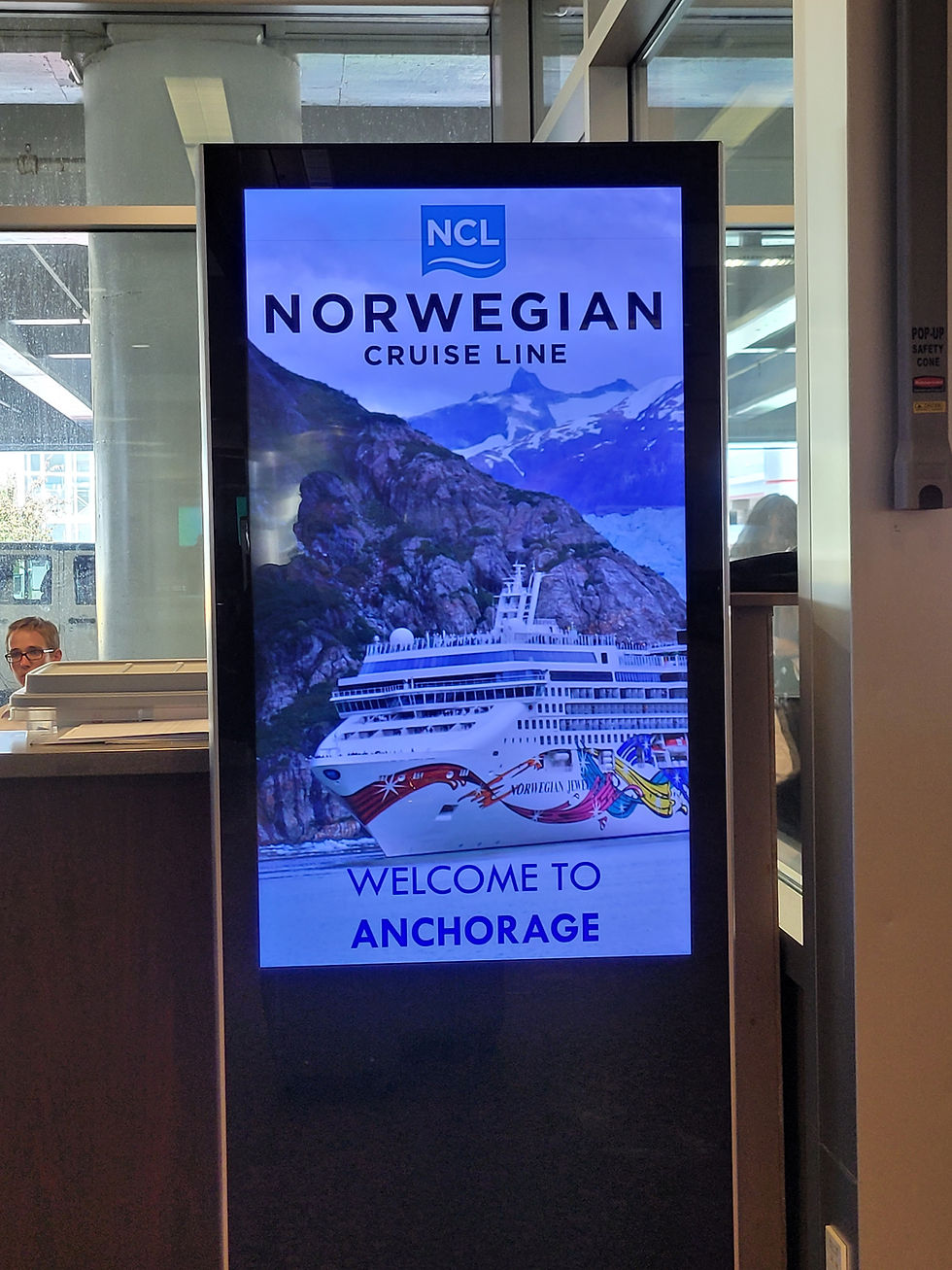
I plan to take a much longer trip to Alaska in the future, because I realized immediately that my time spent there was not long enough. Andy didn't come with me on this trip due to his work schedule, but he did help me plan my trip, and my next trip hopefully will include him... and a cruise, because that's how I'll be able to lure him to Alaska. The irony was not lost on me that one of the first things I saw at the airport upon arriving in Anchorage was an ad from Norwegian Cruise Line welcoming me to Anchorage.
As our aircraft began its initial descent over Alaska at the conclusion of a 6 hour flight, I opened my window shade and was filled with awe at the way the snow-capped mountains peaked through the clouds. The young passenger seated beside me, who couldn’t have been more than 13 or 14 years old, momentarily forgot her fear of flying and let go of the tight grip she had on her grandmother’s hand as she looked out at the mountains in disbelief, also excited about her first trip to Alaska. It was an emotional experience seeing the mountains for the first time, and I have never seen such majesty in my entire life. I could feel the welcoming energy of the mountains, with terrain that looked treacherous and unforgiving, while also gorgeous and pristine at the same time. The view just filled me with love.
Before even stepping off the plane, I immediately decided I needed to come back. When the wheels touched down on the tarmac at Ted Stevens Anchorage International Airport, I promptly texted my husband, “I need to live here.” The outside temperature was a perfect 62°, with a slight 5 mph breeze. I thought everything about the airport was adorable, with baggage carousels and posters plastered with advertisements for things like Arctic Chiropractic and Frontier Soda, championed by cartoon polar bears, moose, and bald eagles as their mascots.
All of the niche airport shops welcomed tourists with the frontier theme, and in the terminal were large life-size taxidermized (or fake?) moose and other wild animals native to the Arctic Circle on display. It was around 3:00 P.M. Alaska Daylight Time (AKDT) when I arrived, which was three hours behind my internal body clock and circadian rhythm. My body was still on Central Standard Time, and I planned to keep it that way for the duration of my trip. Adjusting to the time difference required a strategy to ensure my sleep and digestion were not disrupted before race day.
My trip to Alaska coincided with the Summer Solstice, and as the solstice approaches, Alaska experiences 22 - 24 hours of daylight. Over the following few days, it became the norm for me to go to bed at 6:30 P.M. AKDT, and wake up at 3:00 A.M. AKDT to start my day. This also meant that “dinner” each day was anywhere from 2:00 P.M. to 4:00 P.M. AKDT, and I was unintentionally intermittently fasting in the mornings before breakfast since the hotel and local restaurants and cafes did not start serving breakfast until 6:30 A.M. AKDT, which was 9:30 A.M. for my body. In hindsight, I could have packed some items for breakfast, and as I became more experienced in this journey as a traveling runner, I packed my breakfast on trips with a huge time difference such as my trip to Hawaii in 2025.

The farther north you go in Alaska during the Summer Solstice, the longer the day. In Anchorage, all days between June 8 and July 5 have 24 hours of daylight or civil twilight. So, how did I manage to get any sleep at all with that much sunlight? Under normal circumstances, when I’m at home, I’m super particular about my sleep hygiene ritual in that I must sleep in absolute darkness — cocooned in a black hole in which no light can escape.
My husband reminds me daily that I’m a bat trapped in a human body. I have blackout curtains layered over a pull-down shade in every window, which cover a set of thick blinds that are kept shut. I cover all sources of artificial light with black duct tape or black electrical tape, such as the little red light coming from a TV that is off, or any residual light from electronics that are plugged in. My sleeping conditions would be no different in Alaska. I packed a roll of black duct tape, and that first night in my hotel room, I sealed the curtains to the windowsill with the tape, and clamped them shut with two hangers.
I then rolled up a large towel into a makeshift draft blocker and placed it horizontally at the foot of the door to my hotel room, unplugged the alarm clock radio on the nightstand to extinguish its obnoxious red glow, and then shut off all the lights to ensure I blocked out every possible source of light. When I was satisfied, I turned the lamp on above my nightstand and continued unpacking. The duct tape and hangers were removed prior to checking out of the hotel, of course... I didn't want to create extra aggravation for the housekeeping staff.
I got some of the best sleep I’ve ever gotten in the days leading up to a race – a full, uninterrupted 9 hours, for two nights in a row. Typically I run races on no sleep, or less than 4 hours of sleep due to pre-race anxiety, but I used the time difference in Alaska to my advantage.
The first thing I did after checking into my hotel upon arriving was ensure I made it over to the Alaska Airlines Center on the UAA Campus, where packet pick up and the race expo were being held. I collected my race bib and shirt, and a fun coincidence was my bib for this race was 1-2-3-4. For the LifeTime Chicago Spring Half, which was a month prior, my bib had been 5-6-7-8. Packet pick up was seamless and easy, and the expo was relatively small. Skinny Raven Sports came out to showcase some of their merchandise and apparel.
There wasn’t anything extra we received as far as goodies with our race bib and T-shirt, but the finish festival more than made up for the absence of additional treats at packet pick up. I packed bug spray with me just in case, but I found I didn’t even need it at all during the whole trip. The day prior to the race, I assessed the mosquito situation while I was on my excursion, and made the decision to not put on the bug spray on race morning. I emerged from running in the woods unscathed, with not a single mosquito bite.
The Klondike Express
Friday, June 17, 2022
The next morning, I had a full day planned, which began with breakfast at the Snow City Cafe. If you are visiting Anchorage and decide to stop by the Snow City Cafe, I highly recommend their coffee and the stuffed French toast. The vibe was positively cozy and very much had an industrial meets arctic lodge vibe, and by 6:30 A.M., it was already packed with customers waiting to be seated. All of the dishes at the cafe are made from scratch, and I settled on a small mocha, and the classic French toast with a side of their signature berry butter.
The adventure that followed my breakfast was the opportunity of a lifetime — courtesy of Phillips Cruises & Tours and Saltwater Sunsets Travel — to take a scenic coach bus ride to Whittier, Alaska, and tour the Prince William Sound aboard a catamaran called the Klondike Express. If you are looking to book this same excursion while visiting Alaska, you can find all of the details here: 26 Glacier Cruise & Coach from Anchorage to Whittier. I have never in my life seen such natural beauty. Alaska is so indescribably breathtaking, I felt like I was on another planet. I shared my desire to move to Alaska with one of the locals, and he kindly reminded me that during the winter, Alaska can see up to a foot of snow in a single day on average, and anywhere from 5.3 to 7.25 feet a year.
I went into my excursion expecting to see beautiful glaciers calving, and not only did we see 26 glaciers on our trip and witness sheets of ice elegantly breaking off and falling from the 500 foot shelves of ice, we saw sea otters swimming and hanging out on floating blocks of ice, bald eagles, whales, porpoises, and a black bear. We were instructed to be at the Hotel Captain Cook at 9:00 A.M., where we would meet our coach bus by the 5th Avenue door. I walked over to Hotel Captain Cook from the Snow City Cafe, which was only a block away.
The bus was scheduled to depart from the hotel at 9:15 A.M. after all of the passengers were accounted for, and the coach tour of Whittier was scheduled until 12:15 P.M. After the bus tour, we would board the catamaran that would take us on the 26 Glacier Cruise until 5:00 P.M. The total travel time from Anchorage to Whittier by bus was 90 minutes along the Seward Highway. The Seward Highway follows the shoreline of Turnagain, and winds along the base of mountains, revealing one stunning view after the next.
We stopped to take photos before passing through Girdwood, and then made a pit stop in Girdwood for pastries and to visit the Great Alaskan Tourist Trap gift shop. Our bus driver and tour guide explained that part of the reason for the pit stop was that we needed to time our arrival correctly at the Anton Anderson Memorial tunnel, which runs between Girdwood and Whittier, and is open from 10:30 AM - 10:45 AM for access to Whittier. The Anton Anderson Memorial Tunnel is the longest shared rail and vehicle tunnel in North America. The tunnel operates on a strict time schedule alternating one-way traffic, and traveling through it was unlike anything I’ve ever experienced. It was too fascinating to be creepy, and seemed to be a tight enough space to barely fit a vehicle through, let alone a coach bus.

Our final stop upon exiting the tunnel was Prince William Sound, where the Klondike Express waited to take us on a spectacular journey. The 26 Glacier Cruise followed the route of the 1899 Harriman Expedition, cruising the calm waters of Prince William Sound, where we had the surreal opportunity to view glaciers and wildlife up close. If you’re not familiar with glaciers, they are large, thick masses of ice that form on land when fallen snow gets compressed into ice over many centuries. Seeing one in person is something you likely will never forget, if you’re not used to seeing them up close. It’s incomprehensible how huge they actually are, with some of the largest ones exceeding 500 feet in height.
All I could think of was The Wall in Game of Thrones, which – like a glacier – is described by George R.R. Martin and fans as a colossal fortification which stretches for 300 miles along the northern border of the Kingdom of the North, separating the realm from the domain of the wildlings who live beyond. The Wall is reported to be over 700 feet tall and is made of solid ice. If you haven't already noticed, I am a shameless nerd.
Actual glacier I encountered on my trip, about 100 feet away from us:

The Wall from Game of Thrones:

One could make a clear and convincing argument that George R. R. Martin's "Wall" was inspired by the glaciers of Prince William Sound. There are different types of glaciers, which we learned all about during the tour. Although the temperature all weekend was perfect, I fully expected it to be about ten degrees cooler and a lot windier while traversing the waters of Prince William Sound on our smooth-sailing Klondike Express. In researching this excursion, one of my biggest questions was what to wear and what to bring.
Phillips Cruises and Tours recommended wearing layered, informal clothing and comfortable non-skid shoes. They also suggest bringing a wind and water repellent jacket, sunglasses, a warm hat, and gloves. Other essential items included a smart phone, camera and a USB cord to recharge during the cruise. It was extremely windy, as you can see in my photos, the wind blew up my jacket like a balloon and I look ready to take flight. I got extremely lucky – my assigned seat was right next to a charging station with numerous USB ports (although there were charging stations, there was no WiFi on board). Large bags were discouraged due to the amount of space in the cabin, and there really was no place to put them.
People who brought large bags and backpacks ended up being a bit uncomfortable and had to get creative in where they stored their bags. It was also suggested that we bring cash for the snack bar, and included was a delicious meal that we selected at booking. Lunch was wild Alaskan smoked salmon chowder, oyster crackers, Julienne vegetable salad, cheese squares, fruit snacks, and a Peppermint Patty. There was the option to request Vegetarian Chili or a Kids’ Meal 48 hours prior to departure. I opted for the salmon chowder, after reading many rave reviews and recommendations.

At the port, we were given boarding passes and a meal card. The boarding passes were collected as we boarded, and we were instructed to place our meal cards at the end of our table so the crew could determine who ordered what for lunch. As I mentioned above, there was assigned seating, which depending on how introverted or extroverted you are and how many people you traveled with, could be a welcoming adventure, or an anxiety-inducing nightmare. In my case, I was traveling alone, so I ended up with three strangers at my four-person table who all knew each other, who I had very little in common with, save for the fact that we were all in the same boat. Being the outsider, I was peppered with questions about why I was traveling alone and other personal questions that made for an awkward time while I was seated. Editing this post in 2025, I can tell you as a much more experienced solo traveler today, I have become quite adept at fielding questions about why a woman in her mid-thirties has ventured outside her home without her husband, and I've met many other wonderful solo travelers over the years who are also visiting all 50 states.
I decided I’d spend as little time at the table as possible during the cruise, choosing instead to be outside enjoying the views, or doing laps around the boat inside to enjoy the views and get warm after prolonged wind and cold exposure. The most time spent at my table was to eat lunch, which I was certainly fine with since I didn’t want to miss anything as we sailed past the glaciers. Below is a sample menu describing the meal choices.

Phillips Cruises and Tours boasts a “No Seasickness Guarantee,” which I am happy to report they lived up to that expectation. I am normally someone who gets debilitating motion sickness while on boats or ships, and despite my love for spending time on the water – whether it is by boat, catamaran, or large luxury cruise ship – I always have to ensure I take Bonine at least an hour prior to aquatic voyages. I did not get seasick even a little bit during this experience, which allowed me to fully enjoy the excursion without being inconvenienced by nausea. As a precaution, I had scoped out all of the restrooms on board just in case.
The captain provided a professional narration during the cruise, and when we got farther along our route, a member of the crew fished out a large chunk of glacier ice for us to touch, eat pieces of, and enjoy in our drinks after it was crushed into smaller pieces. One of the novelties is their Glacier Ice Margarita, which I chose to skip unfortunately because I was remaining faithful to my “no alcohol the day before a race” rule.
The Klondike Express did have a full-service bar with Alaskan ales on tap, wine, and a full selection of spirits and liquors, which under different circumstances, I would have enjoyed with the other passengers. Looks like I’ll need to do this excursion again in the future so I can try the Glacier Ice Margarita. It was a long 10-hour day, and I almost fell asleep on the bus ride back to Anchorage, but the experience was worth every minute. Despite how tired I was, I mustered up the energy for a big plate of pasta at Sorrento's. I went with the veggie penne because honestly it looked amazing. With my stomach and my mind full, I fell into a blissful 9 hours of sleep before race morning.

A Long-Distance Race for the Longest Day of the Year
Saturday, June 18, 2022
Every Summer Solstice, for more than 40 years, the Anchorage Mayor's Marathon & Half Marathon has drawn hundreds of runners and spectators from every state, and from many countries around the globe. It was by far one of the most beautiful courses I have ever run thus far in my 16 years of running. This was a point-to-point course that started at the ConocoPhillips Soccer Stadium at Kincaid Park, and finished at the Delaney Park Strip in downtown Anchorage. The half marathon and full marathon both followed the same route until the groups split off at Eastchester Park. We could not have asked for more ideal weather on race morning — it was 55° F, and partly cloudy with a gentle 5 mph breeze. The temperature was expected to remain consistent throughout the event.

The humidity was a surprising 76%. In general, Alaska has an average relative humidity of 77%. You might be just as surprised as I was to learn that our most northern state is at the top of the list for highest relative humidity in the country. The next highest state, Florida, comes in around 74% average relative humidity. Because relative humidity is a measure of the amount of water vapor in the air relative to how much the air can hold, it can be much higher in colder areas despite there being much less actual moisture in the air. This also explains why Alaska doesn’t feel muggy like Florida does in the summer.
Following Alaska and Florida, the other top contenders for most humid states in order are Louisiana, Mississippi, Hawaii, Iowa, Michigan, Indiana, Vermont, and Maine. There was a race day shuttle offered, however I opted to Uber to and from the race, and had no trouble doing so. I chose to Uber instead so I could have a bit more discretion in when I arrived at the race and when I left after the finish, instead of worrying about missing the shuttle or waiting for the shuttle. Many runners opted to use the shuttle or drive if they rented vehicles or brought their own vehicles. My plan and budget for this trip did not include renting a car, so Uber it was. I do believe renting a car for this trip would have significantly enhanced my overall experience and allowed me to see more of Alaska, and this is yet another reason why I'll be planning another trip. My toxic trait is budgeting based on vibes rather than math.
The starting ceremony kicked off sometime around 8:30 A.M., and we were scheduled to cross the start for the marathon and half marathon at 9:00 A.M. About 5 minutes before the start, the electrical equipment tied to the speakers, microphone, and inflatable start arch lost power, and we watched in amusement as our starting line slowly began to deflate and sag right above our heads. By the time they got the power back up and running, everyone was laughing, hoping it was not a negative omen for how the rest of the race would go. We were cautioned to be “bear aware,” and watch out for bears, as they have been known to make an appearance on the course during this race.
My favorite part of the course was definitely the first mile, which took us downhill through a cottonwood forest to the Tony Knowles Coastal Trail, touted as "one of the most beautiful coastal trails in the nation," which had stunning views as promised. Having a completely downhill first mile set the tone for a positive race right out of the gate – and I looked down at my watch and realized I was flying. I put my earbuds in, and had Kate Bush's Running Up That Hill playing on repeat almost the entire time, and I'd later learn that there was no song more fitting for what was about to come next. I reminded myself to reign in the speed a little bit and not get too excited so I could pace myself.
After the first mile through the cottonwood forest, the next 8 miles followed along Cook Inlet with amazing views of the Alaska Range. The entire course remained at 102 feet above sea level. What I quickly began to realize after about 3 miles was that breathing was becoming challenging, and I was not properly acclimated to the humidity, even though the humidity was barely perceptible if you were not engaging in any kind of physical exertion. The course was mostly uphill the first 6 miles, and I felt every bit of it, but some relief was had after Mile 6, right up until the finish line hill.
Tufts of cotton from the cottonwood trees drifted down and floated around us as we ran through the forest, and one runner described it as “Alaska’s summer snow.” I was very thankful I’d brought a running buff to periodically cover my face — which I’d originally intended for the mosquitos friends and family warned me about before my trip — but inhaling a mouthful of cotton would have been equally as unpleasant. My first 8 miles were beautiful, with breathtaking scenery, cool temperatures, and the persistent high humidity that didn't let up. I took advantage of my walk breaks and stops at aid stations to take pictures and videos of the gorgeous course.
Course support was great, and although I was dying of thirst in between every aid station due to my lack of acclimation (and most likely being dehydrated in general), I felt that there were an adequate number of aid stations with plenty of opportunities to replenish fluids and electrolytes. At mile 9, we headed east towards the Chugach Mountains, and the Coastal Trail intersected with the Chester Creek Trail. While passing the Westchester Lagoon there was a cluster of birders out along the course taking photos of the birds and wildlife. We passed mile 11 and the route wove through Eastchester Park, and we switched back to the Chester Creek trail at the turnaround point — traveling west again towards Westchester Lagoon.
The two miles preceding and mile and a half following the turnaround point felt like forever, because we were passing runners going in the opposite direction that we’d been on course with most of the race going in the same direction. Although mile 11 was close to the home stretch, the last 2.5 miles felt like 5, partially because of the humidity (in my case) and also because of the terrain, which wasn’t completely flat. Of course there will always be runners with different experiences than mine who will call what we ran "flat," but those are the same people who don't notice hills on any course. I was reminded of the email we received about two days prior to the race from the race director, apologizing that the course had been measured long, and we would actually be running 13.6 miles instead of 13.1. I needed to conserve my energy for that extra half mile at the end.

My absolute least favorite part of this course was the fact that the finish line was at the summit of a back-breaking, demoralizing mountain. Okay, it was a hill, but after you’ve run nearly an entire marathon or half marathon and you’re excited to finish, the last thing you want to do is climb an almost 90 degree incline for your medal and delicious post-race food. For those of you who take everything literally, please entertain my humor and exaggerations for just a second — humor is one of my coping mechanisms when it comes to demoralizing hills. At the top of the final hill we were greeted by cheering spectators at the Delaney Park Strip downtown, and the last moments of the race after cresting the hill culminated in a fantastic finish festival.
Despite "The Hill," and other hills sprinkled throughout the course, the support for this course was top-notch. The volunteers were energetic and kept us hydrated, and laughing with funny signs, most notably, “Pain is just the French word for bread.” While we're on the topic of bread, one of the key things I wanted to highlight was the amazing post-race food. And I do mean amazing. I can tell you from experience that after running this race, I consumed what was the best grilled cheese I’ve ever had, and I've had thousands of grilled cheeses throughout my lifetime. Sending a special thank you to Franz Bakery. Following the grilled cheese, I made my way to the next tent, which was a bread tent, and scarfed down incredible homemade cinnamon swirl bread with butter, and a chocolate chip cookie fresh out of the oven.
My biggest regret is not getting more than one grilled cheese. And if left alone in that bread tent, I would have eaten the entire loaf of cinnamon swirl. The next morning, I headed home, expecting a smooth trip. Although my time in Alaska ended on a great note, my trip home turned into a 24-hour disaster with my American Airlines flight repeatedly getting delayed. When I finally made it home a day later, at 4:00 A.M. local time, I hadn't slept in 36 hours, and my baggage had been destroyed. American Airlines made it right after many hours on the phone and many emails later, and I used the trip voucher they gave me for my trip to Texas to run the Austin International Half Marathon (formerly 3M Half Marathon) in 2024. In the end, my trip to the Arctic Circle came full circle.
RECOMMENDED LODGING:
Crowne Plaza Anchorage-Midtown
109 W Intl Airport Rd
Anchorage, AK, US, 99518
Happy running and safe travels,

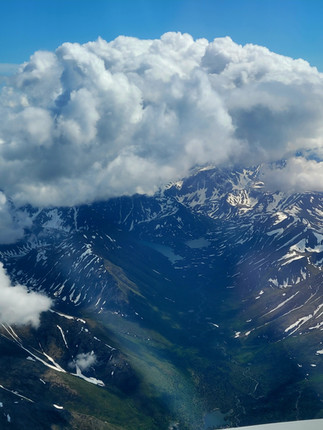















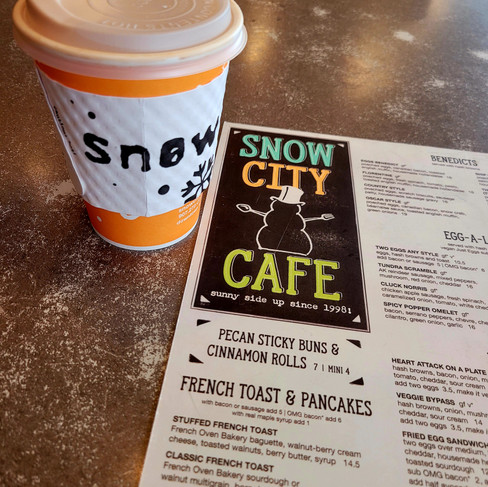

















































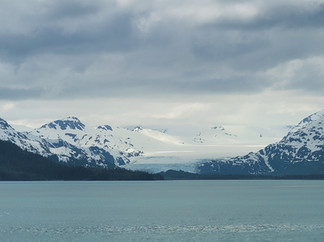

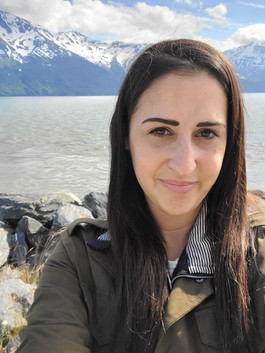













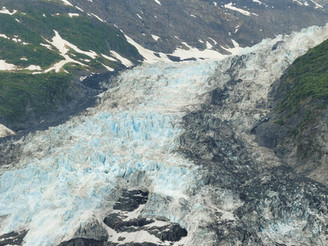





















Comments